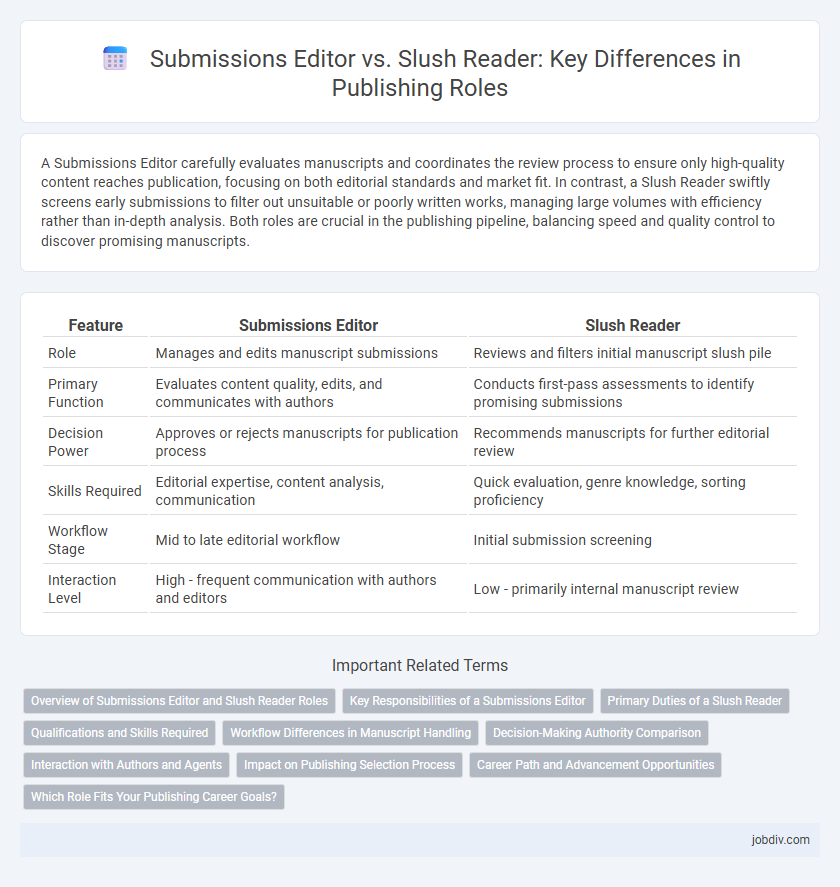A Submissions Editor carefully evaluates manuscripts and coordinates the review process to ensure only high-quality content reaches publication, focusing on both editorial standards and market fit. In contrast, a Slush Reader swiftly screens early submissions to filter out unsuitable or poorly written works, managing large volumes with efficiency rather than in-depth analysis. Both roles are crucial in the publishing pipeline, balancing speed and quality control to discover promising manuscripts.
Table of Comparison
| Feature | Submissions Editor | Slush Reader |
|---|---|---|
| Role | Manages and edits manuscript submissions | Reviews and filters initial manuscript slush pile |
| Primary Function | Evaluates content quality, edits, and communicates with authors | Conducts first-pass assessments to identify promising submissions |
| Decision Power | Approves or rejects manuscripts for publication process | Recommends manuscripts for further editorial review |
| Skills Required | Editorial expertise, content analysis, communication | Quick evaluation, genre knowledge, sorting proficiency |
| Workflow Stage | Mid to late editorial workflow | Initial submission screening |
| Interaction Level | High - frequent communication with authors and editors | Low - primarily internal manuscript review |
Overview of Submissions Editor and Slush Reader Roles
The Submissions Editor oversees the entire manuscript review process, managing submission flow, coordinating with authors and reviewers, and making decisions on potential publications. In contrast, the Slush Reader primarily handles initial screening of unsolicited manuscripts, identifying promising works for further evaluation. Both roles are essential in streamlining content acquisition and maintaining quality standards within publishing houses.
Key Responsibilities of a Submissions Editor
A Submissions Editor manages the entire manuscript intake process, overseeing submissions to ensure they meet the publisher's guidelines and standards. They evaluate and categorize submissions, coordinate with reviewers, and make preliminary decisions on which works proceed to the next editorial stage. By maintaining clear communication with authors and streamlining workflow, Submissions Editors play a crucial role in shaping the publisher's content acquisition strategy.
Primary Duties of a Slush Reader
A slush reader primarily evaluates unsolicited manuscript submissions to identify works that align with the publication's editorial standards and genre focus. They provide detailed feedback on narrative structure, character development, and overall readability to assist editors in shortlisting promising manuscripts. This role involves initial content filtering, ensuring only high-quality and relevant submissions reach the submissions editor for further consideration.
Qualifications and Skills Required
A Submissions Editor typically requires strong editorial skills, excellent judgment in content selection, and experience with manuscript evaluation, often holding a degree in literature, journalism, or a related field. A Slush Reader usually needs a keen eye for quality writing, the ability to assess large volumes of submissions efficiently, and strong communication skills, with less formal education required but a passion for reading and publishing preferred. Both roles demand attention to detail, organizational abilities, and familiarity with publishing industry standards to ensure high-quality content reaches the editorial team.
Workflow Differences in Manuscript Handling
Submissions Editors oversee the entire manuscript evaluation process, managing initial sorting, coordinating peer reviews, and making final decisions on acceptance or rejection. Slush Readers primarily perform first-pass readings, filtering large volumes of unsolicited manuscripts to identify those worthy of detailed editorial attention. The workflow divergence centers on the Submissions Editor's strategic decision-making role versus the Slush Reader's focus on high-volume preliminary assessment.
Decision-Making Authority Comparison
A Submissions Editor holds greater decision-making authority than a Slush Reader, as they not only review submissions but also curate selections and influence final publishing decisions. Slush Readers primarily perform initial screening, filtering content based on guidelines without having the power to approve or reject works independently. This hierarchical distinction ensures that Submissions Editors shape the editorial direction, while Slush Readers support by managing volume and identifying promising manuscripts.
Interaction with Authors and Agents
A Submissions Editor maintains direct communication with authors and agents, providing personalized feedback and guidance throughout the review process, enhancing the submission's potential for acceptance. In contrast, a Slush Reader primarily evaluates unsolicited manuscripts in large volumes with minimal interaction, focusing on filtering content for quality and fit. The Submissions Editor's role fosters stronger professional relationships, while the Slush Reader acts as an initial gatekeeper in the publishing workflow.
Impact on Publishing Selection Process
Submissions Editors play a critical role in the publishing selection process by conducting initial manuscript evaluations and ensuring alignment with editorial standards, thereby influencing the quality and direction of published content. Slush Readers filter large volumes of unsolicited manuscripts, providing a preliminary assessment that significantly streamlines the workload for senior editors and accelerates the identification of promising works. Together, these roles enhance efficiency and selectivity, directly impacting the diversity and caliber of titles chosen for publication.
Career Path and Advancement Opportunities
A Submissions Editor typically manages the review process, coordinating with authors and editorial teams to evaluate manuscript quality, positioning them for senior editorial roles. In contrast, a Slush Reader primarily filters unsolicited submissions, gaining foundational experience that often leads to opportunities as an Assistant Editor or Editorial Assistant. Both roles serve as critical entry points in publishing careers, offering distinct pathways for advancement based on responsibility and decision-making scope.
Which Role Fits Your Publishing Career Goals?
A Submissions Editor manages the flow and evaluation of manuscripts, ensuring quality and alignment with the publication's standards, ideal for those seeking strategic decision-making roles in publishing. A Slush Reader primarily reviews unsolicited submissions, offering early access to emerging talent and valuable experience in manuscript assessment for entry-level professionals. Choosing between the two depends on your career goals; aspiring editors aiming to influence publication direction may prefer Submissions Editor positions, while those focused on manuscript screening and gaining foundational evaluation skills might find Slush Reader roles more suitable.
Submissions Editor vs Slush Reader Infographic

 jobdiv.com
jobdiv.com